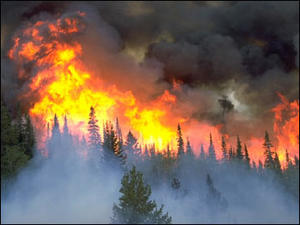Nuclear mattersLos Alamos nuclear waste safe from wildfire
A wildfire is raging near the Los Alamos national Lab; the fire, in some places, is only yards away from the lab’s outside perimeter — and it is eight miles from the so-called Area G; the Area G site is a 63-acre storage facility where thousands of drums of nuclear waste sit, many of which are outdoors started; the good news is that there is no danger that the fire will reach Area G because in 2000, an even more intense fire burned 90 percent of the forest that covered the area between the current fire and the nuclear waste disposal site, making it impossible for the current wild fire to reach the nuclear material on storage

Wildfire has been encroaching on Los Alamos laboratory // Source: kcoy.com
In 2000, a raging wildfire near the Los Alamos National laboratory in new Mexico burned about 90 percent of dense forest and undergrowth on the west side of the lab. It was looked at as a disaster at the time, but now that wild fires are raging again near the lab — as of yesterday (Thursday, only 3 percent of the fire has been contained), that 10-year old fire is regarded as a plus.
The current wild fire may be, in some places, only a few yards from the lab’s outside perimeter, but it is about eight miles from Area G — and the area in between the current fire and Area G is the area in which more than 90 percent of the flammable material was burned ten years ago.
Charles Mansfield, who worked as a physicist at the lab for seventeen years and who is also a forest firefighter, told Science that he was “not very concerned” about the fire reaching spreading east to Area G.
“It would be very difficult for the fire to get that far,” he says. Science notes that sometimes embers in a hotly burning fire can be lofted as much as four miles to start what is called “spot fires.” This, however, requires a forest burning completely, from the ground to the high branches, Mansfield says. The area of forest close enough to have a chance to create the heat and updrafts required to bring the blaze to Area G was already burned ten years ago, meaning that the grass and brush required to get the trees on fire are gone.
